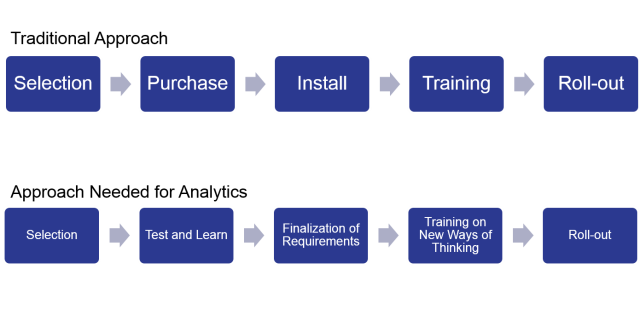The sun is shining brightly through the conference room windows as I listen to the consultants talk. It’s buzzword bingo at its finest. The air is thick. It is comical. The term ‘big data’ is all the rage. The market has dried up for large Enterprise Resource Planning (ERP) implementations, and the large consultants are prowling the market staking their claim for their next gig.
For me, buzzword bingo on big data is bad. The wrong discussions drives detrimental behaviors. Wave your hands and close your eyes and think about the terms that you have heard. It includes the Internet of Things, Digital of Everything, and Commerce of Anything. Few have grounded definitions and concrete ties to analytical architectures. As a result, confusion reigns. We are at a software and consulting junction point… a disruption of sorts. The large Enterprise Resource Planning (ERP) implementation market is coming to a close. It has been the drug of choice for the consultants for many years, and they are repositioning.
Today, we know analytics is exciting. We just are not clear on the outcome. All we know is that we are evolving. The hard work lies ahead.
A Critical Look at the Market
IBM is good at manufacturing terms that I both hate and love. They are a big marketing machine. Recent terms include ominchannel and big data. While IBM is great at developing these thought-leading concepts, they are good at bringing these concepts to life through their solutions. The analysts add to the cause and the hype-cycle ignites. My advice? Sidestep the hype. Do not use the big data lexicon. Set boundaries at team meetings and steer conversations away from industry IT jargon, superlatives, and hollow words. The next step is to drive real projects with real results. This is where the magic happens. In the words of one of my clients yesterday, “Growth solves all ills.” Steve’s burning platform is the use of analytics to drive growth through micromarketing and segmentation. It makes sense. His business is under attack. They are losing market share. He needs a persistence layer, an application layer, and a visualization layer. He needs to redefine commercial processes in the front office. He is clear on the many shortcomings of the conventional definition of Customer Relationship Management (CRM), and has management support. He understands that the persistence, the application, and the visualization elements must work together. The discussion is not about science projects. Instead, the focus is on real results. Sensing demand from channel data, pushing it through demand sensing and forecasting, actively designing and evaluating mirocampaigns, and analyzing customer sentiment data. Steve wants to redefine demand. I am his coach. While your burning platform is probably different, the key point is to have it grounded in the business reality.
In a similar vein, SAP HANA has a huge marketing machine behind its launch. I question is if the price is worth the value. Priced in RFPs as $1.6 million per terabyte, versus $250,000-$500,000 for Teradata, or $150,000-$200,000 for Cloudera, HANA is expensive. While the manufacturing clients who I work with have strong IT relationships with SAP, and HANA is more and more a discussion, SAP lacks the relationships with the business leadership teams. In the process of pushing HANA on the organization, I think we are missing several basic discussions. One mistake is to focus the conversation on IT. Instead, focus on business value. The HANA architecture is well-suited for large, transactional reporting, in-memory applications. It is less of a fit for unstructured data (weather, maps, social, sentiment, warranty, quality, contract documents and pictures) and streaming data (sensors, RFID, and telematics). However, only 12% of companies can get to total cost data, and the average company has 5-7 ERP instances, so if companies want to spend large amounts of money on a new architecture, who am I to judge? I just think that it is expensive and limited in value when a whole world of new forms of analytics lies ahead of us.
What Does Need to Change
The most fundamental thing that companies need to do now is to change their mindset. It is a paradigm shift of the tallest order. There are five basic tenants of project management which do not fit well in the analytics environment. However, changing these will fly in the face of all work processes. Talk through these before you start analytical process development because, as you will see, traditional thinking is your enemy. To be successful, you will need to break traditional program management tenants. Attack these early in your evolution:
1) The How. The Traditional Models.
The traditional project management approach is an RFP, a project plan, an implementation plan, a training plan and a rollout schedule. For analytics, the logic is flawed. What needs to change?
While in the traditional methodologies companies define an “as is” and a “to be” state and then define a project plan, you will need to change this thinking. In analytical projects you do not know what you do not know. The project team needs the courage to fund a project without a well-defined “to be” state. They also need to insert a stage in the project plan to enable the team to test-and-learn. To move forward, write the contract with phased payments after test-and-learn, and allow the team to work with the technology to prove the business case. Do not force teams to do documented phased process flows and a definitive ROI before test-and-learn. It will kill the projects that you need to do. Instead, set aside $100,000-$250,000 to enable testing-and-learning on a compelling business proposition. After testing-and-learning, then commit to the larger project.
However, in the rollout, do not forget to tackle the change management and the well-embedded process definitions. The project evolution is a continual series of test-and-learn. Encourage teams around the world to test-and-learn and refine the technologies. Have contests, small share groups, and sponsor innovation labs. Spawn a test-and-learn culture.
Figure 1. Changing the How

In the process, keep the large consulting teams at bay, and at arm’s-length. Successful analytics projects require two to three deep experts. Do not hire a large BIG-6 consulting partner to redefine your analytics strategies. They are best used in the rollout and management of a known project. I find the brightest minds in this area in the best-of-breed analytics/technology companies and a few thought leaders in leading consulting companies. There are not enough of them. Getting the right fit is essential for project success.
2) The What. After test-and-learn, focus on the project justification. A mistake that many companies make is asking the team to do detailed “as is” and “to be” process mapping before the test-and-learn phase. Do not force the team to do detailed process mapping until after testing-and-learning is complete.
3) Rethink What Is Possible. Don’t settle for the automation of today’s processes. The traditional approaches have resulted in efficient, but brittle, processes with teams unable to perform what-if analysis, simulations, and visualization. Sidestep legacy system approaches. Brainstorm use cases and learn.
4) Let the Computer Work for YOU! Today’s supply chains run on spreadsheets. Despite millions of dollars spent on APS/ERP, Excel is the planning tool of choice. Why? People like to touch data even though it is well-proven that touching data adds little value. In the commercial world of sell, deliver, make, and source processes, we do not have the time or money to fund data scientists. Instead, put the computer to work.
To do this, the teams need to have analytical skills, computer programming acumen, and business process understanding. One of the reasons that the business process outsourcing to India has failed is the lack of business process understanding.
Finding this talent in one person is a rare combination. The answer is to build teams with complementary skills, and focus on maximizing the value of new forms of analytics. Erase your Excel ghettos, remove your teams of low-cost, outsourced workers and harness the power of cognitive learning, artificial intelligence, pattern recognition, combinatorial math, and visualization to drive new insights into your processes.
5) Lead with Business Leaders. While Information Technology (IT) teams lead traditional projects, change this paradigm. Start the journey to use new forms of analytics using business leaders. Unleash the power of analytics for your business, but sidestep buzzword bingo. When you hear the buzzwords, show the service provider the door.
It has been a long week. I have been on the road for two weeks. My fingers are busy typing new reports for our newsletter and we just completed our 133rd podcast. We hope to complete 200 by the end of the year. In this podcast, I had the pleasure to interview a Turkish Grocery Leader, SOK markets. Install the podcast player and hear the voice of Mustafa Altindag. I love his advice on analytics and change management. It is our goal, at Supply Chain Insights, to capture the voices of supply chain leaders globally. Let us know if you would like to participate in the program.
So these are my thoughts on supply chain analytics. I look forward to hearing from you. Do you agree? Have thoughts to share? I would love to hear yours. Meanwhile, I am off to the gym. My old, tired body needs a run on the treadmill. I have been on the road for two weeks. My body is tired.
____________________
 Life is busy at Supply Chain Insights. We are working on the completion of our new game–SCI Impact!– for the public training in Philadelphia in June and August and the content for the Supply Chain Insights Global Summit in September. Our goal is to help supply chain visionaries, around the world, break the mold and drive higher levels of improvement.
Life is busy at Supply Chain Insights. We are working on the completion of our new game–SCI Impact!– for the public training in Philadelphia in June and August and the content for the Supply Chain Insights Global Summit in September. Our goal is to help supply chain visionaries, around the world, break the mold and drive higher levels of improvement.
About the Author:
 Lora Cecere is the Founder of Supply Chain Insights. She is trying to redefine the industry analyst model to make it friendlier and more useful for supply chain leaders. Lora has written the books Supply Chain Metrics That Matter and Bricks Matter, and is currently working on her third book, Leadership Matters. She also actively blogs on her Supply Chain Insights website, at the Supply Chain Shaman blog, and for Forbes. When not writing or running her company, Lora is training for a triathlon, taking classes for her DBA degree in research, knitting and quilting for her new granddaughter, and doing tendu (s) and Dégagé (s) to dome her feet for pointe work at the ballet barre. Lora thinks that we are never too old to learn or to push the organization harder to drive excellence.
Lora Cecere is the Founder of Supply Chain Insights. She is trying to redefine the industry analyst model to make it friendlier and more useful for supply chain leaders. Lora has written the books Supply Chain Metrics That Matter and Bricks Matter, and is currently working on her third book, Leadership Matters. She also actively blogs on her Supply Chain Insights website, at the Supply Chain Shaman blog, and for Forbes. When not writing or running her company, Lora is training for a triathlon, taking classes for her DBA degree in research, knitting and quilting for her new granddaughter, and doing tendu (s) and Dégagé (s) to dome her feet for pointe work at the ballet barre. Lora thinks that we are never too old to learn or to push the organization harder to drive excellence.

Please Don’t AI Stupid
Drip. Drip. Drip. Industry 4.0. DripBig Data. Drip.The Connected Supply Chain. DripDigital Supply Chain. Drip.Autonomous Supply Chain Planning. Drip. Self-Healing Supply Chains. Drip. Touchless Supply





